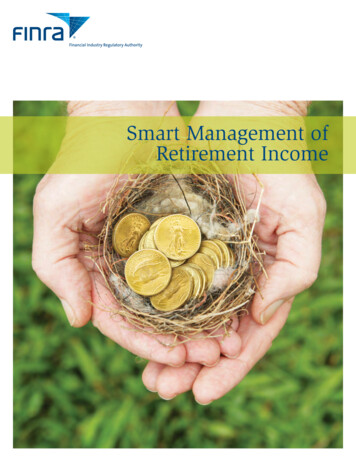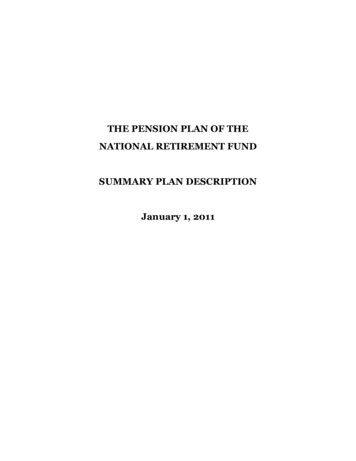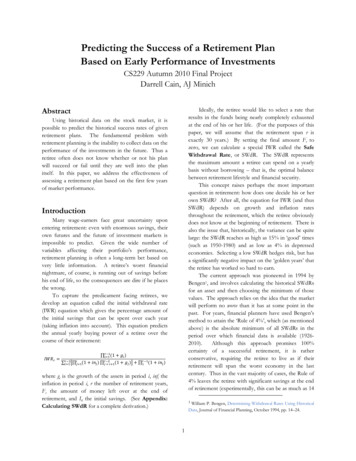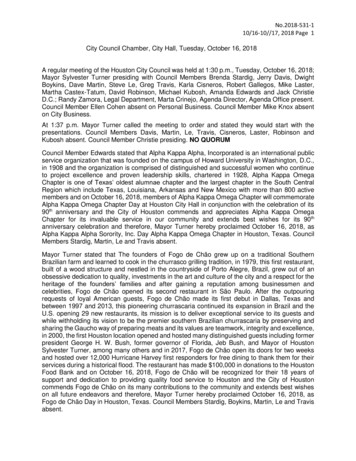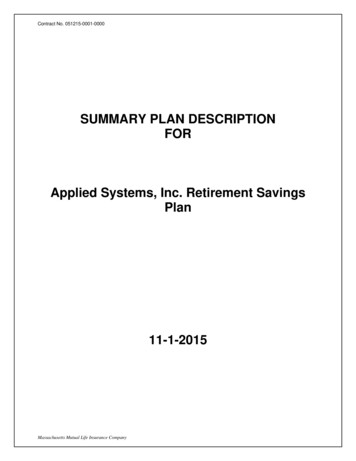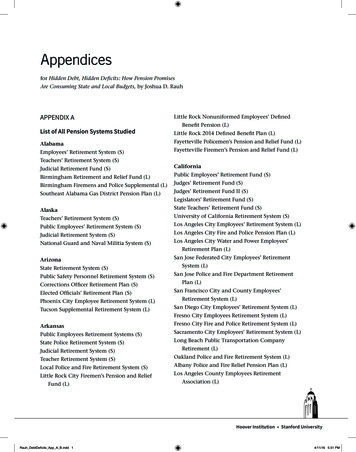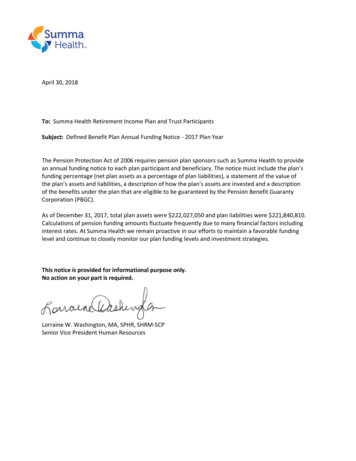
Transcription
April 30, 2018To: Summa Health Retirement Income Plan and Trust ParticipantsSubject: Defined Benefit Plan Annual Funding Notice - 2017 Plan YearThe Pension Protection Act of 2006 requires pension plan sponsors such as Summa Health to providean annual funding notice to each plan participant and beneficiary. The notice must include the plan’sfunding percentage (net plan assets as a percentage of plan liabilities), a statement of the value ofthe plan’s assets and liabilities, a description of how the plan’s assets are invested and a descriptionof the benefits under the plan that are eligible to be guaranteed by the Pension Benefit GuarantyCorporation (PBGC).As of December 31, 2017, total plan assets were 222,027,050 and plan liabilities were 221,840,810.Calculations of pension funding amounts fluctuate frequently due to many financial factors includinginterest rates. At Summa Health we remain proactive in our efforts to maintain a favorable fundinglevel and continue to closely monitor our plan funding levels and investment strategies.This notice is provided for informational purpose only.No action on your part is required.Lorraine W. Washington, MA, SPHR, SHRM-SCPSenior Vice President Human Resources
Supplement to Annual Funding Notice of Summa Health Retirement Income Plan and Trust (Plan)Plan Year Beginning January 1, 2017 and Ending December 31, 2017 (Plan Year)This is a temporary supplement to your annual funding notice which is required by the Moving Ahead for Progress in the 21stCentury Act, the Highway and Transportation Funding Act of 2014, and the Bipartisan Budget Act of 2015. These federal lawschanged how pension plans calculate their liabilities. The purpose of this supplement is to show you the effect of thesechanges. Prior to 2012, pension plans determined their liabilities using a two-year average of interest rates. Now pension plansalso must take into account a 25-year average of interest rates. This means that interest rates likely will be higher and planliabilities lower than they were under prior law. As a result, your employer may contribute less money to the plan at a timewhen market interest rates are at or near historical lows.The “Information Table” compares the impact of using interest rates based on the 25-year average (the “adjusted interestrates”) and interest rates based on a two-year average on the Plan’s: (1) Funding Target Attainment Percentage, (2) FundingShortfall, and (3) Minimum Required Contribution. The funding target attainment percentage is a measure of how well the planis funded on a particular date. The funding shortfall is the amount by which liabilities exceed net plan assets. The minimumrequired contribution is the amount of money an employer is required by law to contribute to a plan in a given year. Thefollowing table shows this information determined with and without the adjusted interest rates. The information is provided forthe Plan Year and for each of the two preceding plan years, if applicable.Information TablePlan Year Beginning 2017Funding equiredContributionPlan Year Beginning 2016Plan Year Beginning 5% 0 14,406,801 0 14,696,405 0 32,234,773 0 3,065,830 0 3,209,066 0 6,072,232Page 2
Supplement to Annual Funding Notice of Summa Health Retirement Income Plan and Trust (Plan)Plan Year Beginning January 1, 2017 and Ending December 31, 2017 (Plan Year)IntroductionThis notice includes important information about the funding status of your single-employer pension plan (the “Plan”). It alsoincludes general information about the benefit payments guaranteed by the Pension Benefit Guaranty Corporation (“PBGC”), afederal insurance agency. All traditional pension plans (called “defined benefit pension plans”) must provide this notice everyyear regardless of their funding status. This notice does not mean that the Plan is terminating. It is provided for informationalpurposes and you are not required to respond in any way. This notice is required by federal law. This notice is for the plan yearbeginning January 1, 2017 and ending December 31, 2017 (“Plan Year”).How Well Funded Is Your PlanThe law requires the administrator of the Plan to tell you how well the Plan is funded, using a measure called the “fundingtarget attainment percentage.” The Plan divides its Net Plan Assets by Plan Liabilities to get this percentage. In general, thehigher the percentage, the better funded the plan. The Plan’s funding target attainment percentage for the Plan Year and eachof the two preceding plan years is shown in the chart below. The chart also shows you how the percentage was calculated.Funding Target Attainment Percentage1. Valuation DatePlan Year Beginning in2017Plan Year Beginning in2016Plan Year Beginning in2015January 1, 2017January 1, 2016January 1, 2015 219,273,362 218,237,075 199,908,677 0 0 0 7,877,207 7,288,986 7,440,018 211,396,155 210,948,089 192,468,659 184,476,769 184,296,258 179,229,973114.59%114.46%107.38%2. Plan Assetsa. Total Plan Assetsb. Funding Standard Carryover Balancec. Prefunding Balanced. Net Plan Assets (a) – (b) – (c) (d)3. Plan Liabilities4. Funding Target Attainment Percentage (2d)/(3)Plan Assets and Credit BalancesThe chart above shows certain “credit balances” called the Funding Standard Carryover Balance and Prefunding Balance. A planmight have a credit balance, for example, if in a prior year an employer contributed money to the plan above the minimumlevel required by law. Generally, an employer may credit the excess money toward the minimum level of contributions requiredby law that it must make in future years. Plans must subtract these credit balances from Total Plan Assets to calculate theirFunding Target Attainment Percentage.Plan LiabilitiesPlan Liabilities in line 3 of the chart above is an estimate of the amount of assets the Plan needs on the Valuation Date to payfor promised benefits under the plan.Page 3
Year-End Assets and LiabilitiesThe asset values in the chart above are measured as of the first day of the Plan Year. They also are “actuarial values.” Actuarialvalues differ from market values in that they do not fluctuate daily based on changes in the stock or other markets. Actuarialvalues smooth out those fluctuations and can allow for more predictable levels of future contributions. Despite thefluctuations, market values tend to show a clearer picture of a plan’s funded status at a given point in time. As of December 31,2017, the fair market value of the Plan’s assets was 222,027,050. On this same date, the Plan’s liabilities, determined usingmarket rates, were 221,840,810.Participant InformationThe total number of participants and beneficiaries covered by the Plan on the Valuation Date was 7,244. Of this number, 2,750were current employees, 2,678 were retired and receiving benefits, and 1,816 were retired or no longer working for theemployer and have a right to future benefits.Funding & Investment PoliciesEvery pension plan must have a procedure to establish a funding policy for plan objectives. A funding policy relates to howmuch money is needed to pay promised benefits. The current funding policy of the Plan is to contribute no less frequently thanannually an amount at least equal to the minimum contribution required by law. Summa Health may, at its discretion,contribute amounts in excess of the minimum required contribution.Once money is contributed to the Plan, the money is invested by plan officials called fiduciaries. Specific investments are madein accordance with the Plan’s investment policy. Generally speaking, an investment policy is a written statement that providesthe fiduciaries that are responsible for plan investments with guidelines or general instructions concerning various types orcategories of investment management decisions.Pension plans also have investment policies. These generally are written guidelines or general instructions for makinginvestment management decisions.The investment policy of the Plan is as follows:The core mission and primary goal of the Plan is to provide pension benefits for the beneficiaries covered under the SummaHealth Retirement Income Plan and Trust agreement. The Plan’s asset base and the returns generated from the investmentportfolio constitute an important source of funding to support the primary goal of the Plan. In order to assure the continuationof the Plan, a long-term investment strategy was adopted that aligns the asset base with the Plan’s benefit obligations. Theinvestment objectives of the Plan are: To generate a real (inflation adjusted) annual compound rate of return that covers benefit and expense obligations.To exceed total return created by a passive policy benchmark.The passive policy benchmark is defined as the weighted sum of the product of the policy target allocation for each asset classto the performance of the asset class benchmark. The long-term asset allocation policy that has been adopted is: Public Equity35%, Fixed Income 40%, Real Estate 10%, Master Limited Partnerships 5%, Alternatives 5%, and Cash & Equivalents 5%.Under the investment policy, the Plan’s assets were allocated among the following categories of investments, as of the end ofthe Plan Year. These allocations are percentages of total assets:Asset AllocationsPercentageStocks37.7%Investment grade debt instruments38.8%High-yield debt instrumentsReal estateOther2.7%8.8%12.0%Page 4
Right to Request a Copy of the Annual ReportPension plans must file annual reports with the US Department of Labor. The report is called the “Form 5500.” These reportscontain financial and other information. You may obtain an electronic copy of your Plan’s annual report by going towww.efast.dol.gov and using the search tool. Annual reports also are available from the US Department of Labor, EmployeeBenefits Security Administration’s Public Disclosure Room at 200 Constitution Avenue, NW, Room N-1515, Washington, DC20210, or by calling 202.693.8673. Or you may obtain a copy of the Plan’s annual report by making a written request to the planadministrator. Annual reports do not contain personal information, such as the amount of your accrued benefits. You maycontact your plan administrator if you want information about your accrued benefits. Your plan administrator is identifiedbelow under “Where To Get More Information.”Summary of Rules Governing Termination of Single-Employer PlansIf a plan terminates, there are specific termination rules that must be followed under federal law. A summary of these rulesfollows.There are two ways an employer can terminate its pension plan. First, the employer can end a plan in a “standard termination”but only after showing the PBGC that such plan has enough money to pay all benefits owed to participants. Under a standardtermination, a plan must either purchase an annuity from an insurance company (which will provide you with periodicretirement benefits, such as monthly, for life or for a set period of time when you retire) or, if the plan allows, issue one lumpsum payment that covers your entire benefit. Your plan administrator must give you advance notice that identifies theinsurance company (or companies) selected to provide the annuity. The PBGC’s guarantee ends upon the purchase of anannuity or payment of the lump-sum. If the plan purchases an annuity for you from an insurance company and that companybecomes unable to pay, the applicable state guaranty association guarantees the annuity to the extent authorized by thatstate’s law.Second, if the plan is not fully-funded, the employer may apply for a distress termination. To do so, however, the employermust be in financial distress and prove to a bankruptcy court or to the PBGC that the employer cannot remain in businessunless the plan is terminated. If the application is granted, the PBGC will take over the plan as trustee and pay plan benefits, upto the legal limits, using plan assets and PBGC guarantee funds.Under certain circumstances, the PBGC may take action on its own to end a pension plan. Most terminations initiated by thePBGC occur when the PBGC determines that plan termination is needed to protect the interests of plan participants or of thePBGC insurance program. The PBGC can do so if, for example, a plan does not have enough money to pay benefits currentlydue.Benefit Payments Guaranteed by the PBGCWhen the PBGC takes over a plan, it pays pension benefits through its insurance program. Only benefits that you have earned aright to receive and that cannot be forfeited (called vested benefits) are guaranteed. Most participants and beneficiariesreceive all of the pension benefits they would have received under their plan, but some people may lose certain benefits thatare not guaranteed.The amount of benefits that PBGC guarantees is determined as of the plan termination date. However, if a plan terminatesduring a plan sponsor’s bankruptcy, then the amount guaranteed is determined as of the date the sponsor entered bankruptcy.The PBGC maximum benefit guarantee is set by law and is updated each calendar year. For a plan with a termination date orsponsor bankruptcy date, as applicable in 2018, the maximum guarantee is 5,420.45 per month, or 65,045.40 per year, for abenefit paid to a 65-year-old retiree with no survivor benefit. If a plan terminates during a plan sponsor’s bankruptcy, themaximum guarantee is fixed as of the calendar year in which the sponsor entered bankruptcy. The maximum guarantee is lowerfor an individual who begins receiving benefits from PBGC before age 65 reflecting the fact that younger retirees are expectedto receive more monthly pension checks over their lifetimes. Similarly, the maximum guarantee is higher for an individual whostarts receiving benefits from PBGC after age 65. The maximum guarantee by age can be found on PBGC’s website,www.pbgc.gov. The guaranteed amount is also reduced if a benefit will be provided to a survivor of the plan participant.Page 5
The PBGC guarantees “basic benefits” earned before a plan is terminated, which include: Pension benefits at normal retirement age; Most early retirement benefits; Annuity benefits for survivors of plan participants; and Disability benefits for a disability that occurred before the date the plan terminated or the date the sponsor enteredbankruptcy, as applicable.The PBGC does not guarantee certain types of benefits: The PBGC does not guarantee benefits for which you do not have a vested right, usually because you have not workedenough years for the company. The PBGC does not guarantee benefits for which you have not met all age, service, or other requirements. Benefit increases and new benefits that have been in place for less than one year are not guaranteed. Those that havebeen in place for less than five years are only partly guaranteed. Early retirement payments that are greater than payments at normal retirement age may not be guaranteed. For example,a supplemental benefit that stops when you become eligible for Social Security may not be guaranteed. Benefits other than pension benefits, such as health insurance, life insurance, death benefits, vacation pay, or severancepay, are not guaranteed. The PBGC generally does not pay lump sums exceeding 5,000.In some circumstances, participants and beneficiaries still may receive some benefits that are not guaranteed. This depends onhow much money the terminated plan has and how much the PBGC recovers from employers for plan underfunding.For additional general information about the PBGC and the pension insurance program guarantees, go to the “General FAQsabout PBGC” on PBGC’s website at www.pbgc.gov/generalfaqs. Please contact your employer or plan administrator for specificinformation about your pension plan or pension benefit. PBGC does not have that information. See “Where to Get MoreInformation,” below.Where to Get More InformationFor more information about this notice, you may contact Summa Health or Amy Danylchak, at 1077 Gorge Boulevard, Akron,OH 44310; 234.312.6060; or danlychaka@summahealth.org. For identification purposes, the official plan number is 010 and theplan sponsor’s name and employer identification number or “EIN” are Summa Health and 34-1887844.Disclosure Statement and DisclaimerThis notice is intended to comply with the requirements of section 101(f) of the Employee Retirement Income Security Act of1974, as amended. The disclosures provided in this notice are based on information available and believed to be accurate as ofthe date this notice is provided. All computations reflected in these disclosures have been performed based on a good faithinterpretation of the applicable statutory and regulatory guidance in effect on the date this notice is provided. Such informationand computations include, but are not limited to, the measurement of plan liabilities, reported values of plan assets, andallocation of assets. However, actual results for the Plan Year may change and will not be considered final until filed with theDepartment of Labor as part of the Annual Report (i.e., the Form 5500). Subsequently, such results will change only byamendment of the Annual Report for the Plan Year. See the Right to Request a Copy of the Annual Report section forinformation about how to obtain a copy of the Annual Report. The plan sponsor does not undertake any obligation to update orpublicly release any revisions to this notice, and no such revisions will be issued, to reflect any changes, including but notlimited to, changes in the manner in which particular calculations are performed, changes in expectations, the adoption of planamendments or any other events or circumstances occurring after this notice is provided.Page 6
April 30, 2018 To: Summa Health Retirement Income Plan and Trust Participants Subject: Defined Benefit Plan Annual Funding Notice - 2017 Plan Year The Pension Protection Act of 2006 requires pension plan sponsors such as Summa Health to provide an annual funding notice to each plan participant and beneficiary.

